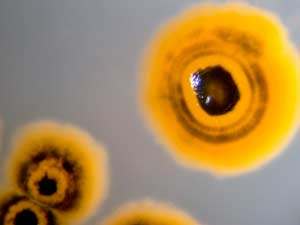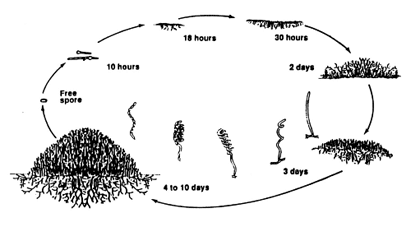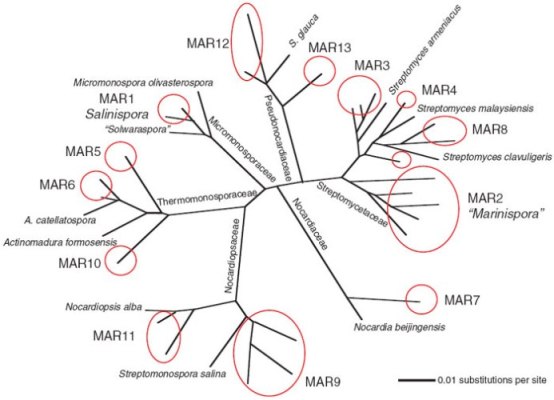
Classification
Domain:
Bacteria
Phlyum: Actinobacteria
Class: Actinobacteria
Order: Actinomycetales
Family: Micromonosporaceae
Genus: Salinispora
Species:
Salinispora tropica
Actinomycetes such as Salinispora tropica are categorized as prokaryotes due to the lack of membrane bound organelles, the incredibly small size, and the fact that it uses binary fission to reproduce. More specifically, actinomycetes are aerobic, gram positive bacteria, that tend to form mycelia-like structures at some stage in the relatively short life cycle. All of these traits are found in Salinispora tropica. To compare these traits with another actinomycete click here.
 Similar to others in the family
micromonosporaceae,
Salinspora tropica forms non-motile spores. However, unlike
others in this family organisms from the genus
Salinispora only form a
substrate mycelium, and reside in ocean water sediments.
Similar to others in the family
micromonosporaceae,
Salinspora tropica forms non-motile spores. However, unlike
others in this family organisms from the genus
Salinispora only form a
substrate mycelium, and reside in ocean water sediments.

The figure above is a very interesting Phylogenetic tree because it shows how many marine actinomycetales are still unknown. The most extensively studied branch of the tree are the members of the Salinispora genus. This tree shows six families of actinomycetes branching out of the middle, which all seem to be related to terrestrial species of this order. The one factor that binds these bacteria together is the presence of secondary metabolites shown to have medicinal purposes in humans.


The picture on the right above shows the gamma proteobacteria e. coli. Another interesting bacteria is an epsilon proteobacteria H. pylori.
The tree on the left above shows the molecular similarities in bacterial species in relation to archea. The branch they occupy on the tree is based on the 16S rRNA sequence. Due to lateral gene transfer the history of how the bacterial groups came to be is unknown. In addition, the branching patterns are not well understood. Actinobacteria specifically show many similarities including the fact that marine actinomycete species are salinophiles and require saltwater for growth.
If you have ever wanted to travel to the tropics you will love this organisms habitat!
Back to the Beginning.